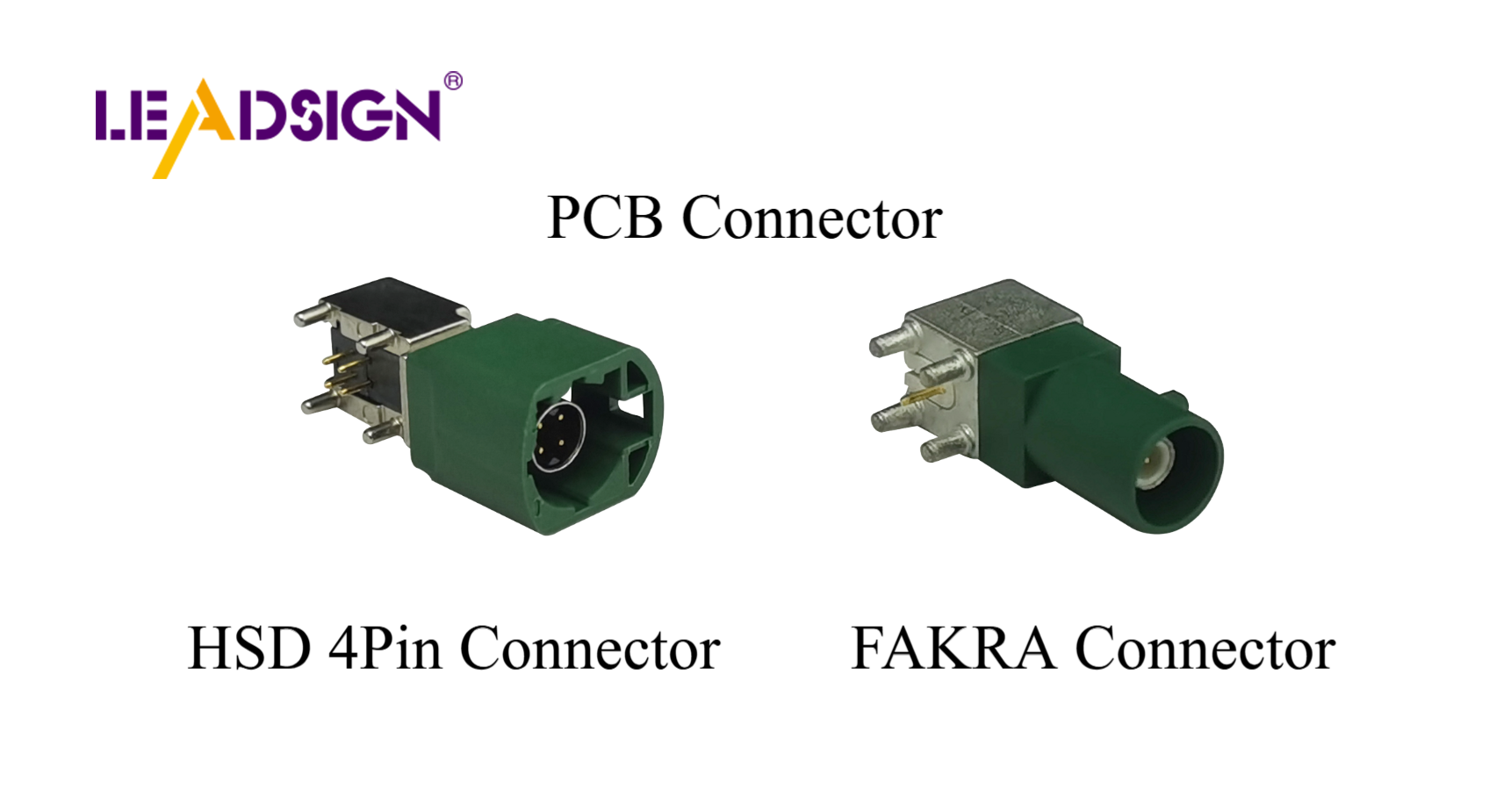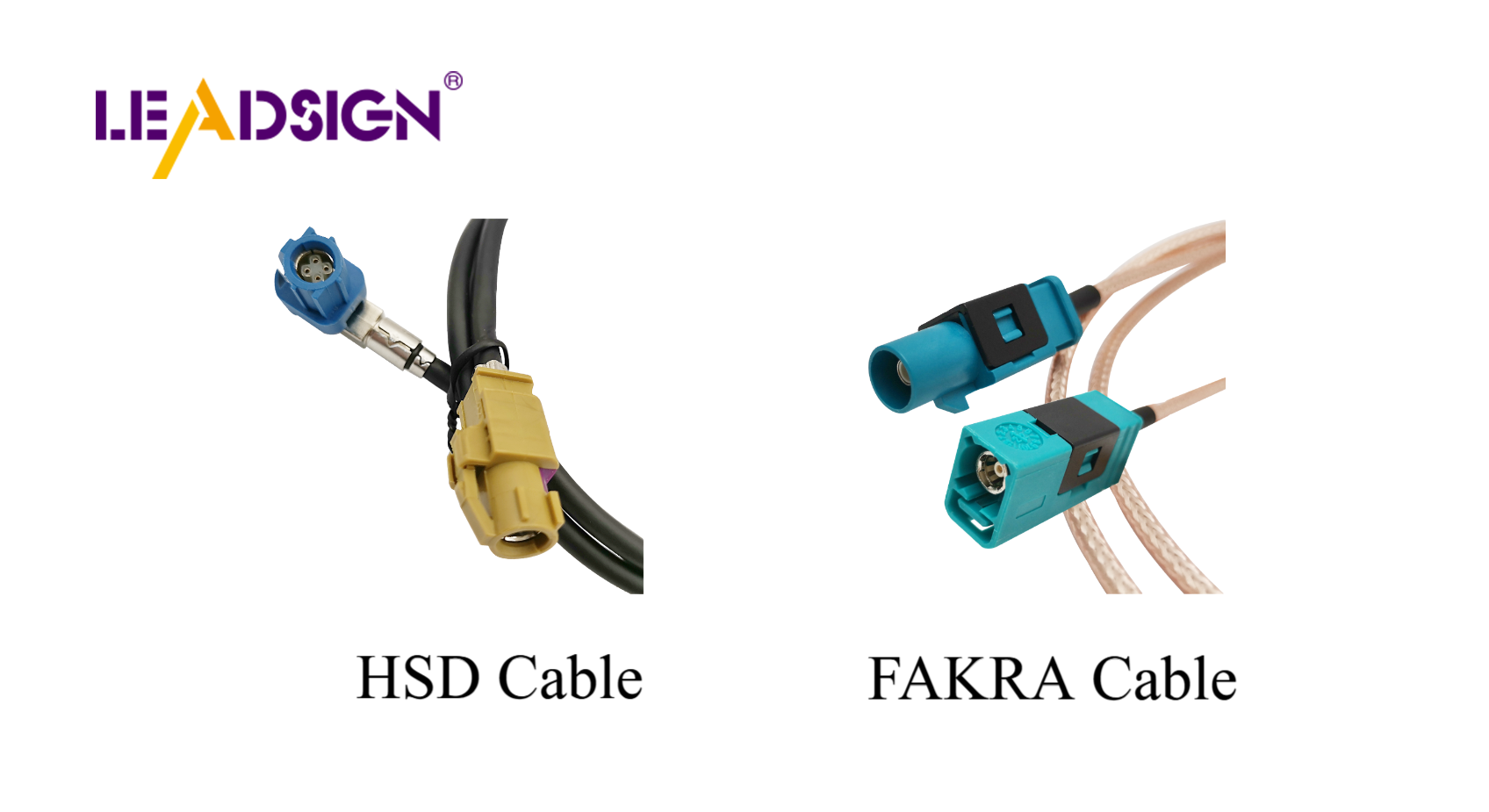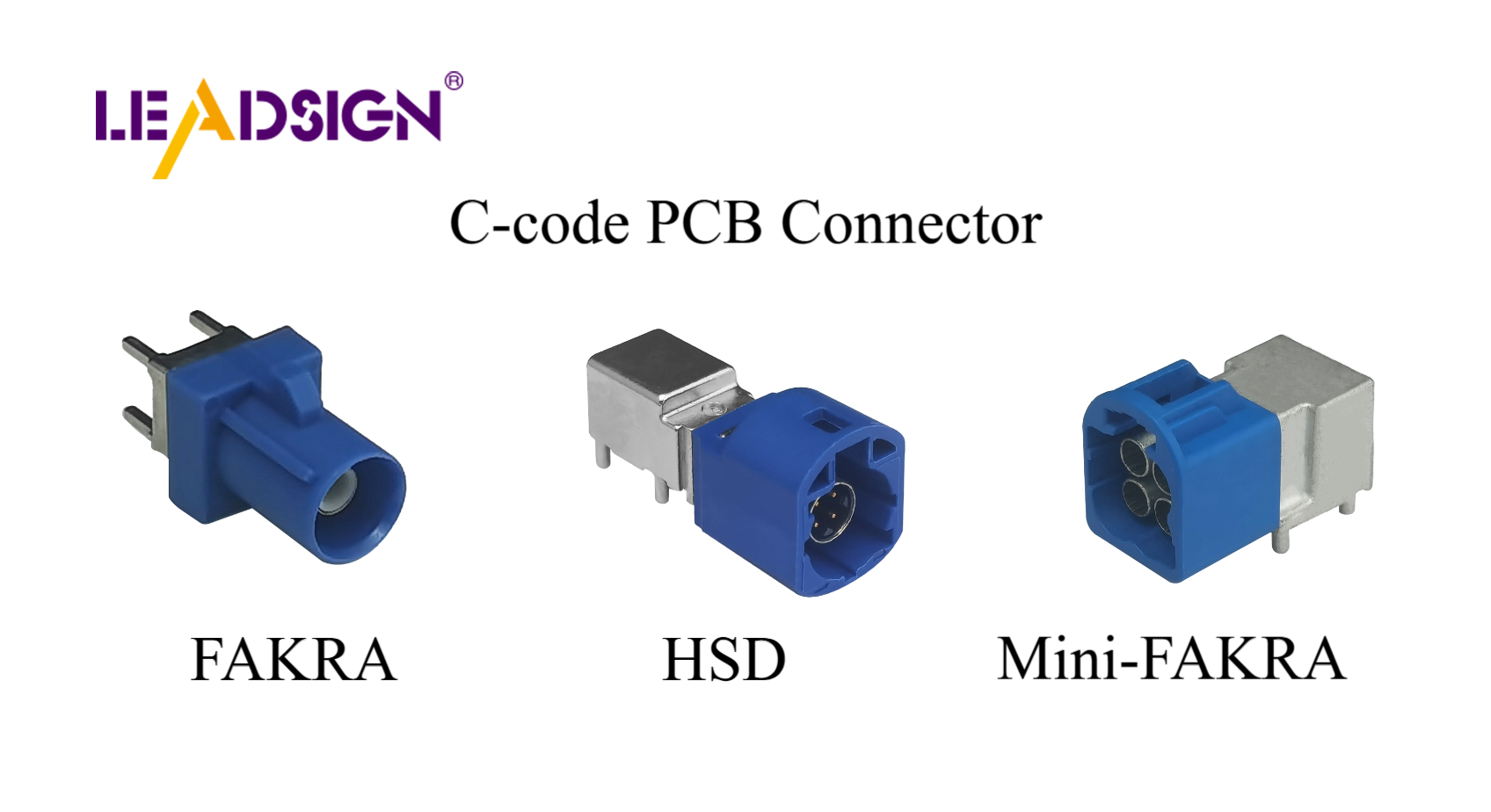Types of Wire Connectors Automotive: HSD vs FAKRA Comparison

HSD vs FAKRA: A Detailed Comparison
Explore the differences between HSD and FAKRA connectors for automotive applications.
Features | HSD | FAKRA |
|---|---|---|
Size & Shape | Small, fits tight spaces | Bigger, strong locking system |
Materials & Durability | Blocks EMI, stable data transfer | Resists heat, moisture, durable |
Signal Types | Fast data transfer (USB, Ethernet) | RF signals (GPS, radios) |
Bandwidth & Speed | High-speed data, reduced signal loss | Supports up to 8 Gbps, 6 GHz |
Compliance & Standards | Meets fast data transfer rules | Follows FAKRA standard specifications |
Interoperability | Works with cameras, infotainment | Connects with antennas, telematics |
Applications | Infotainment, digital networks | GPS, radio, telematics |
Advantages | Fast data transfer, small size | Strong locking system, clear RF signals |
Limitations | Only for data systems, more expensive | Bigger size, slower for high-speed data |
In cars, automotive electrical connectors types are important for electronic systems to function properly. HSD (High-Speed Data) connectors transmit fast data, making them ideal for videos and infotainment. On the other hand, FAKRA connectors excel in providing steady signals for applications like GPS and radios. They are designed differently to meet specific requirements such as speed and reliability. Understanding these differences is crucial for selecting the best connector for car systems, ensuring everything operates smoothly and efficiently.
Key Takeaways
HSD connectors are ideal for fast data transfer, making them perfect for infotainment systems and advanced driver-assistance systems (ADAS).
FAKRA connectors excel in providing reliable RF signals, making them the go-to choice for GPS and radio applications in vehicles.
When choosing between HSD and FAKRA, consider the type of signal your system requires: HSD for data and FAKRA for RF signals.
HSD connectors are compact and designed to fit in tight spaces, while FAKRA connectors are bulkier but offer a strong locking mechanism for secure connections.
Both connector types are compliant with automotive standards, ensuring compatibility with various car systems.
Using both HSD and FAKRA connectors in a system can enhance performance by leveraging their unique strengths for data and signal transmission.
Evaluate your system's speed, bandwidth needs, and environmental conditions to make an informed choice between HSD and FAKRA connectors.
Key Differences Between HSD and FAKRA Connectors

Design and Construction
Physical structure and size comparison
HSD and FAKRA connectors look different in size and shape. HSD connectors are small and fit into tight spaces in cars. Their compact design works well for modern vehicles with limited room. In contrast, a FAKRA connector is bigger and bulkier. Its larger size includes a strong locking system to stay secure, even with vibrations.
The size difference shows their uses. HSD connectors focus on fast data transfer and fit easily into infotainment systems. FAKRA connectors are built for reliable RF signals, so they are sturdier and slightly larger.
Materials and durability
The materials used in these connectors match their purposes. HSD connectors use high-quality materials to block electromagnetic interference (EMI). This keeps data transfer stable, even with electrical noise around. FAKRA connectors, however, are made to handle tough conditions in cars. They have strong housings to resist heat, moisture, and wear.
Both connectors have locking systems to make them last longer. But FAKRA standard specifications focus on long-term use, making them great for outdoor uses like GPS and radios.
Functionality and Signal Transmission
Signal types supported (data vs RF signals)
The main difference is the type of signals they handle. HSD connectors are great for fast data signals. They are used for USB, Ethernet, and driver-assistance systems. A FAKRA connector, on the other hand, works best with RF signals. It is used for GPS, radios, and car communication systems.
This makes HSD connectors perfect for systems needing quick data transfer. FAKRA connectors are better for reliable RF signals.
Bandwidth and speed capabilities
HSD connectors are faster than FAKRA connectors. They handle high-speed data for multimedia systems. Their design reduces signal loss, even at high frequencies.
FAKRA connectors can support speeds up to 8 Gbps. They work well for RF signals up to 6 GHz, which is enough for most car communication needs. But for large, fast data transfers, HSD connectors are better.
Compatibility and Standards
Compliance with automotive electrical connectors types
Both connectors follow automotive electrical connectors types standards. This ensures they work with different car systems. HSD connectors meet strict rules for fast data transfer, making them ideal for advanced networks. FAKRA connectors follow fakra standard specifications, ensuring reliable RF performance.
Interoperability with other automotive components
Interoperability is important for both connectors. HSD connectors work well with cameras, infotainment systems, and Ethernet networks. Their design prevents signal problems, keeping systems running smoothly. FAKRA connectors connect easily with antennas, GPS, and telematics systems. The different types of fakra connectors make them flexible for various setups.
The way cables attach also matters. HSD connectors use crimp connections for secure attachment. FAKRA connectors have different housing options, making them easy to install in many car systems.
Applications in Automotive Systems

Common Uses for HSD Connectors
Infotainment systems and digital networks
HSD connectors are key in modern car infotainment systems. These systems need fast data to work smoothly. HSD connectors link touchscreens, audio, and video displays. Their small size fits tight spaces in advanced car networks.
Automotive Engineers say HSD connectors keep signals strong, even with EMI. This makes them perfect for systems needing steady data flow.
Advanced driver-assistance systems (ADAS)
ADAS depends on quick data to work well. HSD connectors send fast data for features like lane-keeping and collision alerts. They help cameras and sensors talk without delays.
Automotive Engineers explain HSD connectors handle complex signals in ADAS. Their speed ensures accurate responses, improving car safety.
Common Uses for FAKRA Connectors
GPS and navigation systems
FAKRA connectors are vital for car GPS and navigation. They send steady RF signals for accurate tracking and directions. Their tough design lasts in harsh car conditions.
Industry Experts say FAKRA connectors are trusted for GPS use. Their strength makes them reliable for navigation systems.
Antenna connections for radio and telematics
FAKRA connectors link antennas to radios and telematics. They handle high-frequency signals for clear sound and communication. Their lock system stops disconnections from vibrations.
Automotive Engineers note FAKRA connectors keep RF signals strong. They work well for many car systems, including telematics.
Shared Applications
When both connectors are used together
Some car systems use both HSD and FAKRA connectors. For example, infotainment systems need HSD for fast data and FAKRA for RF signals. Together, they make multimedia and communication features work well.
Automotive Engineers say using both connectors improves car system efficiency. Each one meets specific needs for a balanced setup.
Choosing between HSD and FAKRA
Picking HSD or FAKRA depends on the signal type and system needs. HSD is better for fast data, like in ADAS. FAKRA works best for RF systems, like GPS. Space, durability, and cost also affect the choice.
Industry Experts recommend checking your system’s needs before deciding. Knowing each connector’s strengths helps you choose wisely.
Advantages and Limitations
Benefits of HSD Connectors
Fast data transfer abilities
HSD connectors send data very quickly. They can reach speeds up to 8 Gbps. This speed helps car parts communicate fast and smoothly. They are great for systems like infotainment, which need quick video and audio streaming. The 100-ohm impedance keeps signals steady, even at high frequencies. Using HSD connectors makes data transfer faster and better. This improves how your car's electronics work overall.
Fact: HSD connectors are used in smart cars for clear video signals.
Small size saves space
HSD connectors are small and fit in tight spaces. Their compact size works well in cars with limited room. This is helpful for advanced car systems with many parts in small areas. Choosing HSD connectors helps organize your car's electronics. They save space while still sending data quickly.
Tip: If you need space-saving and fast data, pick HSD connectors.
Benefits of FAKRA Connectors
Strong locking system for secure connections
FAKRA connectors have a strong locking system. This keeps them connected, even with car vibrations. The double-lock design adds extra safety. This makes them reliable for important uses like GPS and telematics.
Insight: Engineers trust FAKRA connectors for their strength and stability.
Built for clear RF signals
FAKRA connectors are made for clear RF signals. They work well for radios and navigation systems. They handle frequencies up to 6 GHz without losing signal quality. Their tough design resists heat and moisture, making them last longer.
Fact: FAKRA connectors are the top choice for RF systems due to their reliability.
Downsides of HSD Connectors
Only for data-based systems
HSD connectors are made for fast data, not RF signals. They don’t work for systems like GPS or radios. If your car needs RF signals, FAKRA connectors are better.
Tip: Check your system’s signal type before picking HSD connectors.
More expensive than basic connectors
HSD connectors cost more because of their advanced features. They are not the cheapest option for simple car systems. If your system doesn’t need fast data, cheaper connectors might work better.
Insight: Think about your budget and needs before choosing HSD connectors.
Limitations of FAKRA Connectors
Bigger size compared to HSD connectors
FAKRA connectors are larger and take up more space. Their strong housing and locking system make them durable. But this also makes them bulky for small car systems. They may not fit well in tight spaces.
On the other hand, HSD connectors are smaller and fit easily. If your car has limited space, FAKRA connectors might be hard to use. Modern cars with advanced systems often need smaller connectors.
Tip: Check your car's space before picking FAKRA connectors. Their size might not work for tight setups.
Slower for high-speed data
FAKRA connectors are great for RF signals but not for fast data. They handle up to 6 GHz and 8 Gbps, which is fine for GPS and radios. But for faster data, like in infotainment, they fall behind.
HSD connectors are made for quick data transfer. They keep signals strong at high speeds, perfect for multimedia systems. FAKRA connectors are reliable for RF signals but not as fast for data needs.
Fact: For fast data, HSD connectors are better. FAKRA connectors work best for steady RF signals.
Picking the Best Connector for Your Car Systems
Things to Think About
Signal type (data or RF)
Choosing between HSD and FAKRA depends on signal type. HSD connectors send fast data signals. They work well for infotainment, Ethernet, and ADAS systems. These connectors help systems share data quickly and smoothly.
FAKRA connectors handle RF signals like GPS and radios. They are strong and reliable, even in tough conditions. If your system needs RF signals, FAKRA is the better choice.
Speed and bandwidth needs
Speed and bandwidth matter when picking a connector. HSD connectors are fast and keep signals clear. They are great for systems needing quick data sharing.
FAKRA connectors can handle up to 8 Gbps and 6 GHz. But they are better for steady RF signals, not fast data. For reliable signals, FAKRA connectors are a good option.
Real-Life Examples
When to use HSD connectors
Use HSD connectors for fast data systems. They are perfect for infotainment with smooth video and audio. They also help ADAS systems by linking cameras and sensors quickly.
HSD connectors are small and block interference. They fit well in tight spaces. If your system needs speed and clear data, choose HSD connectors.
When to use FAKRA connectors
FAKRA connectors are best for RF signal systems. They are used in GPS for accurate tracking and directions. They also connect antennas to radios and telematics for clear communication.
Their tough design works in harsh conditions. If your system needs reliable RF signals and is easy to install, pick FAKRA connectors.
HSD and FAKRA connectors have different jobs in cars. HSD connectors send fast data, great for infotainment and ADAS systems. FAKRA connectors provide steady RF signals, ideal for GPS and radios.
Think about your system's needs when picking a connector. HSD connectors are small and handle fast data well. FAKRA connectors are strong and reliable for RF signals. Both are important for modern cars, helping parts work together smoothly. Choose carefully to improve your car's electronics.
FAQ
What is the main difference between HSD and FAKRA connectors?
HSD connectors send fast data, great for infotainment and ADAS. FAKRA connectors handle RF signals, like GPS and radios. Choose HSD for speed or FAKRA for reliable signals.
Can HSD and FAKRA connectors work together in one system?
Yes, many systems use both types. For example, infotainment uses HSD for data and FAKRA for GPS. Using both improves multimedia and communication performance.
Which connector is best for fast data transfer?
HSD connectors are best for fast data. They support speeds up to 8 Gbps. This makes them ideal for video streaming and Ethernet in cars.
Are FAKRA connectors good for tough conditions?
Yes, FAKRA connectors are made for harsh environments. Their strong design resists heat, moisture, and vibrations, making them reliable for outdoor uses like GPS.
How do I choose between HSD and FAKRA connectors?
Think about your system’s signal needs. Pick HSD for fast data in infotainment or ADAS. Choose FAKRA for RF signals like GPS or radio. Also, consider space, durability, and cost.
Are HSD connectors compatible with USB and Ethernet?
Yes, HSD connectors work well with USB and Ethernet systems. They fit easily into digital networks, making them great for advanced car electronics.
Do FAKRA connectors support high-frequency signals?
FAKRA connectors handle up to 6 GHz frequencies. They work well for GPS, radios, and RF Bluetooth. Their locking system keeps connections stable.
Are HSD connectors more expensive than FAKRA?
Yes, HSD connectors cost more because of their advanced features. They are worth it for systems needing fast and reliable data transfer.
Can FAKRA connectors handle fast data?
FAKRA connectors can manage up to 8 Gbps speeds. But they are better for RF signals, not fast data. For faster data, HSD connectors are better.
Why are FAKRA connectors easy to install?
FAKRA connectors have different housing options and a locking system. This makes them simple to plug in and use for many car systems.
See Also
Unveiling The Advantages Of Fakra Connectors In Cars
Why Fakra Connectors Matter In The Auto Sector
Significance Of Fakra Connectors In Today's Vehicles

